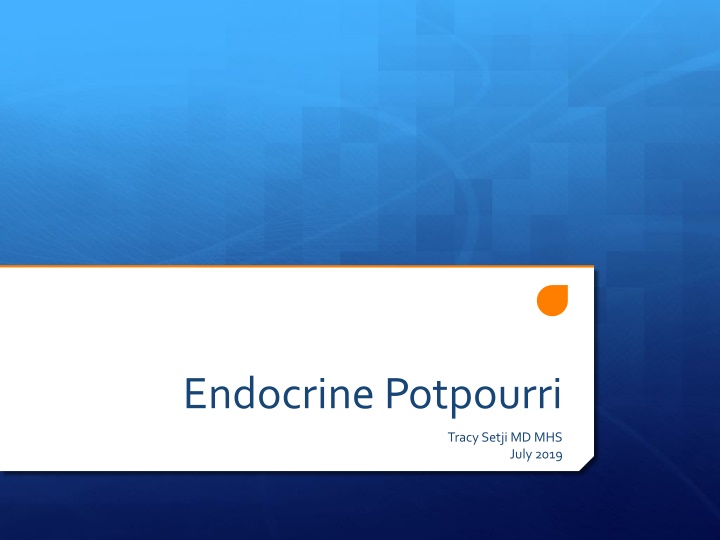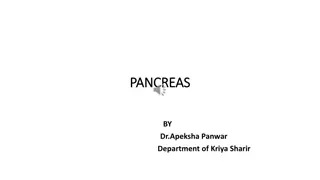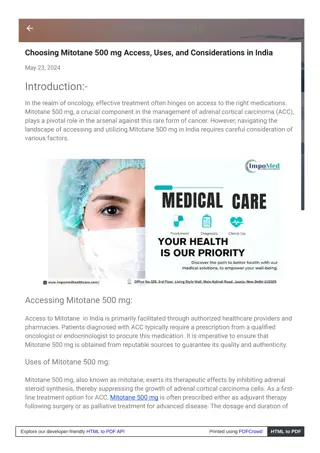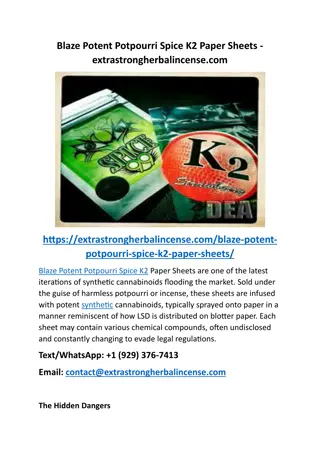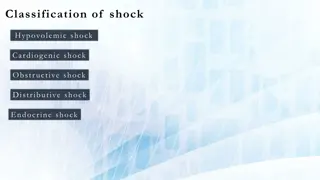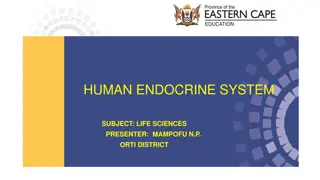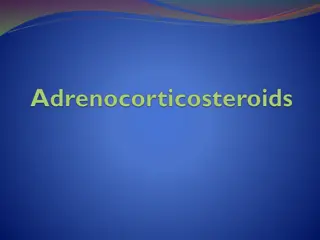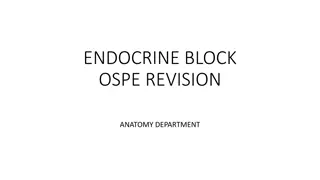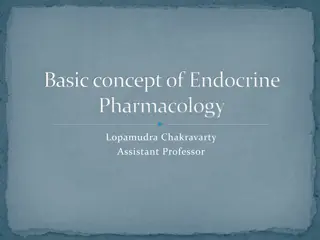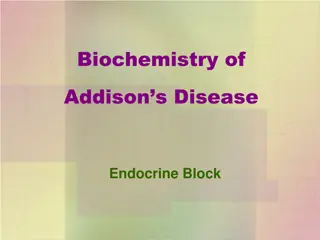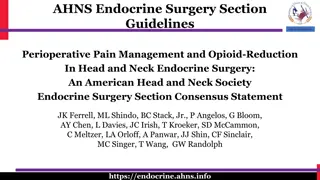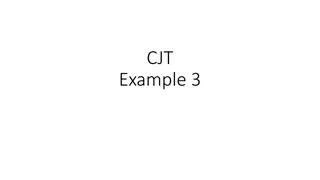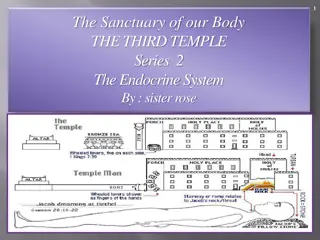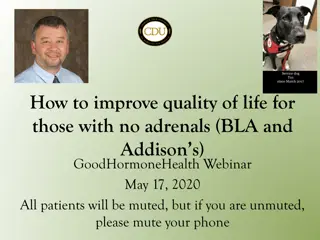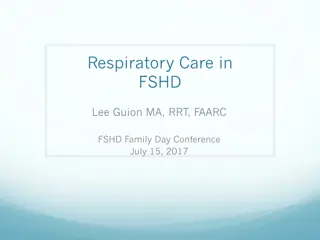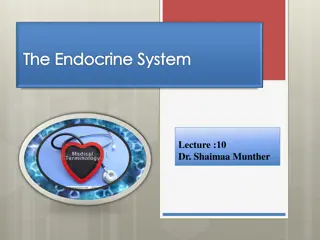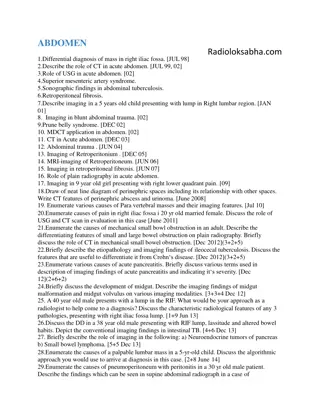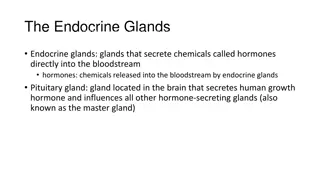Endocrine Potpourri: Adrenal Insufficiency and Incidentalomas - Case-Based Review
This endocrine potpourri covers various cases involving adrenal insufficiency, adrenal crisis, adrenal incidentalomas, and patient education. It includes a detailed case presentation, treatment guidelines for adrenal crisis, patient education on adrenal insufficiency, and evaluation of adrenal nodules. The content emphasizes the importance of recognizing and managing endocrine disorders effectively in clinical practice.
Download Presentation

Please find below an Image/Link to download the presentation.
The content on the website is provided AS IS for your information and personal use only. It may not be sold, licensed, or shared on other websites without obtaining consent from the author.If you encounter any issues during the download, it is possible that the publisher has removed the file from their server.
You are allowed to download the files provided on this website for personal or commercial use, subject to the condition that they are used lawfully. All files are the property of their respective owners.
The content on the website is provided AS IS for your information and personal use only. It may not be sold, licensed, or shared on other websites without obtaining consent from the author.
E N D
Presentation Transcript
Endocrine Potpourri Tracy Setji MD MHS July 2019
Objectives Case based review of Endocrine cases that present in inpatient and outpatient Internal Medicine Adrenal : Adrenal insufficiency and incidentalomas Thyroid: hyper and hypothyroidism, nodules, pearls PCOS No disclosures
Case #1 36 yoF w/ T1DM, hypothyroidism, AI, presents to ED with extreme fatigue, weakness, abdominal pain, N/V, inability to take POs including meds BP 92/54, P 115 lying 72/44, P 138 standing Labs demonstrate sodium 127, K 5.7, glucose 65, no DKA, corrected calcium 10.8.
Case #1 Treatment of Adrenal Crisis Hydrocortisone 100 mg IV x 1, followed by 50 mg IV q 6 hrs (or continuous infusion 200mg/24 hr) Volume resuscitation Once stabilizes, wean steroids to lower doses IV then to PO. Maintenance doses HC 15-25 mg/day in 2-3 divided doses Cortisone acetate 20-35 mg/day in 2-3 divided doses Prednisolone (3-5 mg/day) Fludrocortisone required if aldosterone deficiency JECM 2016;101:364; Endocrine 2017;55:336
Adrenal Insufficiency Patient Education Sick day rules Steroid emergency card or medical alert identification Glucocorticoid injection kit and education on use Follow with Endocrine at least once per year JECM 2016;101:364; Endocrine 2017;55:336
Case #2 62 yo M presents for follow up of SOB/pneumonia, s/p recent hospitalization. CT scan chest found incidental 2 cm R adrenal nodule (10 Hounsfield units). HTN, hyperlipidemia, obesity HCTZ, ACEi, CCB BP 144/88, HR 85, BMI 34 PE significant for central obesity, otherwise unremarkable
What should you do to evaluate adrenal incidentaloma? No further work up is needed Assess for hyperaldosteronism Assess for hyperaldosteronism, subclinical cushings Assess for hyperaldosteronism, subclinical cushings, subclinical pheo Assess for subclinical cushings and pheo
Evaluation of Adrenal Nodules Need hormonal evaluation to rule out Cushings (including subclinical) MN salivary cortisol, 1 mg dex supp test, 24 hr UFC Pheo (including subclinical) Plasma free metanephrines, 24 hr urine metanephrines Hyperaldo, if pt has HTN or electrolyte abnormalities to suggest hyperaldosteronism Renin and aldo screen Imaging Low Hounsfield units (<10) reassuring that it is a benign adenoma If <4cm, looks benign on imaging, and is not producing hormones, repeat imaging in 3-6 months, then annually for 1-2 yrs Endocrine Practice 2009 (15): Suppl 1
Case #3 40 yo F w/ h/o celiac disease presents w/ complaints of palpitations and sweating ROS: Frequent bowel movements, increased appetite, no change in wt, increase in anxiety. Eyes feel a little more dry than normal and some grittiness. FamHx: Maternal aunt with thyroid disorder, s/p RAI SocHx: +tobacco use, rare Etoh
Case #3 PE: HR 110, BP 140/84, BMI 27 HEENT: +lid lag, mild R proptosis, no chemosis, +mild conjunctival injection Neck: thyroid mildly enlarged, nontender, no bruit, no nodules CV: tachycardic but no M/R/G Neuro: +fine tremor on exam Skin: warm, moist, no rash
Case #3 You suspect thyrotoxicosis and send TSH and FT4 TSH <0.01 Ft4 3.9
What is the most likely cause of her symptoms? Graves disease Thyroiditis Overactive nodule(s) Thyroid hormone ingestion
How do you determine etiology of thyrotoxicosis? Historically, uptake and scan have been first step in evaluation Two parts: Uptake (normal 10-30%) Scan is a picture of thyroid ie. hot/cold nodules Uptake will also help identify whether thionamides will work High uptake states can be treated with antithyroid medications (thionamides)
Hyperthyroid states High uptake Graves disease Most common cause in young to middle-aged people Circulating immunoglobulin attaches to TSH receptor and stimulates formation of goiter and excessive production of thyroid hormone Toxic nodular goiter Multinodular middle-aged to elderly people. Probably results from development of autonomy in longstanding goiters Solitary Pregnancy thyroid follicular cells are stimulated by hCG (ie. Molar pregnancy, choriocarcinoma) Pituitary resistance to thyroid hormone regulation rare TSH secreting pituitary tumor rare Thyroid 2016;26:1343-1420
Nonhyperthyroid Thyrotoxic States Low uptake Thyroiditis liberation of thyroid hormone from the gland (subacute, silent, postpartum, amiodarone-induced, IFN, IL2, radiation) Does NOT respond to thionamides Treat symptoms w/ BB Ingestion of pharmacological preparations or food containing thyroid hormone Ectopic hormone production from thyroid tissue in abnormal locations (lingual goiter, struma ovarii, metastatic thyroid disease) May see uptake elsewhere with whole body imaging Thyroid 2016;26:1343-1420
Are there other cost effective ways to determine the etiology? Thyrotropin receptor antibodies (TRAb) or Thyroid Stimulating Immunoglobulin (TSI) Positive in Graves disease Indicate that antithyroid medications will work to control thyroid hormone production There may be large cost differential b/w the two studies Other antibodies Anti-TPO (antimicrosomal) Anti-thyroglobulin Can be positive in Graves or other thyroid disease (hashimoto s or chronic autoimmune thyroiditis) Less helpful in determining whether antithyroid medications will work to control thyroid hormone production
Back to case #3- Graves disease Given age, gender, h/o personal autoimmune disorder and family h/o thyroid disease, and physical exam, you suspect Graves disease Check TRAb (or TSI) If positive, can treat with thionamide therapy If negative, would proceed with uptake and scan to evaluate for nodule(s) vs. thyroiditis Case 3 TRAb came back positive. How do we treat?
Treatment Beta blockers Hyperthyroid symptoms are secondary to increased beta adrenergic receptors BB help control symptoms of thyrotoxicosis from any cause Propranolol in high dose can block T4 to T3 conversion, but most pts can be treated w/ metoprolol or atenolol on outpt setting Thyroid 2016;26:1343-1420
Thionamides PTU and methimazole Patients with high uptake states (Graves, nodules) will respond to thionamide therapy Block de novo thyroid synthesis within 1-2 hours Transported into the thyroid gland where they inhibit both the organification of iodine to tyrosine residues in thyroglobulin and the coupling of iodotyrosines May also inhibit thyroid hormone secretion PTU also inhibits peripheral conversion of T4 to T3 Methimazole is first line agent EXCEPT in first trimester of pregnancy and storm (use PTU) Thyroid 2016;26:1343-1420
Case #3 Graves disease Pt is started on BB and methimazole 20 mg daily 2-3 wks later, hyperthyroid symptoms are improved FT4 has come down to 2.6 and BB and methimazole are continued
Patient returns 6 wks later with complaints of fevers and sore throat A) Reassure her that she has viral infection B) Check CBC; hold methimazole until results obtained C) Stop methimazole and refer to Endocrine D) Change from methimazole to PTU
Side effects of thionamides Agranulocytosis (ANC <500) >70% develop agranulocytosis within 60 days, nearly 85% within 90 days Most pts present with fever 92% and sore throat 85%, thus pt instructed to call if they have fever and sore throat check WBC Sheng et al, QJMed 92:455-61, 1999; Nakamura JCEM 98:4776, 2013 Hepatotoxicity More common with PTU (black box warning) but can occur with w/ methimazole also. Pt instructed to call if jaundice, pruritus, RUQ pain, scleral icterus, darkening of urine check LFTs Anca-associated vasculitis Pt instructed to call if they develop rash Thyroid 2016;26:1343-1420
Case #4 73 yo AAF w/ h/o hyperthyroidism, s/p discontinuation of propylthiouracil (PTU) 7 days ago for a planned thyroid uptake and scan. Presents w/ a 2 day h/o lethargy, slurred speech and low grade temp. N/V on day of admission
Case #4 - Physical Exam HR 120-170 on telemetry, temp 100.5, very lethargic HEENT: +stare and lid lag; no proptosis or chemosis; sclera anicteric Neck: thyroid enlarged and nodular, no bruit CV: Reg rhythm but tachycardic Resp: Fair respiratory effort, no crackles Ext: No c/c/e Neuro: Brisk reflexes, fine tremor present What are you concerned about?
Thyroid Storm Clinical Presentation Thyrotoxicosis features are accentuated: Thermoregulatory dysfunction Low grade temp temp >104 (sweating can lead to insensible fluid loss) Cardiovascular Tachycardia HR >140; afib; CHF CNS disturbance Agitation delirium, psychosis, extreme lethargy seizure coma N/V/D jaundice Precipitant history usually present Thyroid 2011;21:593; J Int Care Med 2015;30:131 Endocrinol Metab Clin North Am 1993;22:263
Atypical presentations Apathetic hyperthyroidism May present with apathy, obtundation, cardiac failure Elderly or those with nonthyroidal illness may not have typical signs and symptoms of thyrotoxicosis, which can lead to delay in diagnosis J Int Care Med 2015;30:131
Laboratory Testing in Thyroid Storm No definitive serum T4 or T3 cutoff to differentiate storm (from thyrotoxicosis without crisis) T3 may not appear as high as expected in critically ill patients because of decreased ability to convert T4 to T3 Common abnormalities: leukocytosis (+/- infection), elevated BUN, elevated transaminases, hyperbilirubinemia, hypercalcemia (high bone resorption), hyperglycemia (increased catecholamines and gluconeogenesis, inhibition of insulin release) J Int Care Med 2015;30:131
Treatment of thyroid storm Beta-adrenergic blockade Propranolol PO 60-80 mg Q 4 hrs; Can use IV for faster effect (0.5 to 1.0 mg slow IV push then 1-2 mg at 15-min intervals while monitoring on telemetry Alternative (i.e. if borderline BP): Esmolol IV Antithyroid drug therapy (thionamides) PTU preferred: +/-Load 500-1000 mg PO, then 200-250 mg q4hr Methimazole: 60-80 mg/day, in divided doses Usually PO, but can be suppository or retention enema Thyroid 2011;21:593, J Int Care Med 2015;30:131; Thyroid 2006;16:691
Treatment of thyroid storm Iodine blocks release of T4 and T3 from the thyroid gland and new hormone synthesis Inhibit organic binding of iodide to TG in the thyroid (Wolff-Chaikoff effect) Transient decrease in thyroid hormone synthesis Escape phenomenon eventually occurs, usually within 2-4 wks, and thyroid hormone synthesis resumes SSKI (saturated solution of potassium iodide) 5 drops (0.25mL or 250 mg) PO every 6 hours OR Lugol s solution 8 drops every 6 hours Administer one hour after antithyroid medication has been given (to prevent iodine from being used as substrate for new thyroid hormone synthesis) Would recommend Endocrine consultation in anyone you are considering SSKI Thyroid 2011;21:593, J Int Care Med 2015;30:131
Treatment of thyroid storm Glucocorticoids inhibit T4 to T3 conversion Hydrocortisone +/- 300 mg IV load, then 100 mg IV q 8 hours; alternative is dexamethasone Other Lithium impairs thyroid hormone release and blocks new synthesis and is alternative if pt has h/o iodine induced anaphylaxis; renal and neuro toxicity limit usefulness Cholestyramine binds conjugated thyroid products in gut, thus promotes excretion and lowers thyroid hormone levels Physical removal Plasma exchange removes TBG w/ bound thyroid hormone. Colloid replacement supplies open binding sites for circulating free thyroid hormone Supportive treatment: APAP, cooling blankets, IVF, resp support, ICU monitoring Avoid salicylates Can increase FT4 by decreasing binding to T4 binding globulin Thyroid 2011;21:593, J Int Care Med 2015;30:131
Definitive therapy for Hyperthyroidism Graves disease Can treat for 12-18 months with methimazole after which about 1:4 will go into remission and be able to come off methimazole Continue thionamide long term (less likely to consider this in young pt) Radioactive iodine therapy destroys thyroid tissue, majority end up needing thyroid replacement Known to exacerbate thyroid eye disease Surgical resection consider if pt has large nodule(s), particularly if the nodules have concerning features on U/S MNG or solitary nodule Won t go into remission; thus consider definitive therapy with RAI or surgery Thyroid 2016;26:1343-1420
Case #5 72 yo M w/ h/o CAD, cardiac arrhythmia treated w/ amiodarone x 1 yr, now with thyrotoxicosis (TSH undetectable, FT4 3 x normal) Initial evaluation to help determine if the pt has Amiodarone induced hyperthyroidism type 1 vs. 2 PE: Look for thyroid eye disease, thyroid nodules/goiter Check TRAb for underlying Graves and U/S to look at architecture (nodules?) and evidence of thyroiditis
Amiodarone induced hyperthyroidism Type 1 Likely secondary to the large iodine load on a pre- existing state of thyroid disease (Graves or nodules) Ongoing thyroidal organification and thyroid hormone synthesis May see increased vascularity on doppler Thionamide therapy will help control levels Type 2 Destructive thyrotoxicosis from either the iodine or the drug itself Thyroid is not making more thyroid hormone but releasing the preformed thyroid hormone Steroids are best therapy Thyroid 2016;26:1343-1420
Case #5 - AIT If history, PE and evaluation clearly suggest AIT 1 or AIT2, treat with methimazole or steroids, respectively Often, it is challenging to distinguish b/w the AIT1 and AIT2 and/or pt is fairly sick requiring timely intervention Methimazole 40 mg and prednisone 40 mg daily If respond quickly, suggests prednisone is the predominant therapy that is working and thus can taper methimazole down and potentially off Amiodarone can affect thyroid for several months
Case #6 45 yo F presents with fatigue, wt gain, dry skin/hair TSH is 40, FT4 0.45 How do you treat her? Levothyroxine 1.6 mcg/kg is usual wt based estimation Start lower if h/o cardiac disease or older pt (ie. 25-50 mcg daily) Take apart from food or meds (usually morning, but HS will work too) What if TSH was 6 w/ FT4 normal? Could check anti-TPO (antimicrosomal) and if positive, would consider starting LT4 25 mcg daily if pt had symptoms of hypothyroidism If subclinical hypothyroidism and +Abs, overt hypothryoidism occurs at rate of 4.3% per year Endocrine Practice 2012;18:988-1028
Case #7 85 yo M with no known thyroid disorder has TSH 7.0 Symptoms: none PMHx: CAD, HL, HTN
What should you do next? A) Start levothyroxine 50 mcg daily B) Start levothyroxine at weight based 1.6 mcg/kg/day C) Monitor thyroid but do not start levothyroxine D) Order thyroid ultrasound
TSH in elderly pts Rising TSH is expected with aging Experts recommend a higher TSH level (>7.5 or 8.5 IU/ml) in elderly pts Potential risk of over-replacement with levothyroxine is NOT outweighed by potential benefit of treating subclinical hypothyroidism in this population Thus recommend rechecking TSH in 4-8 wks JAMA Intern Med 2016;176:1741-1742
Case #8 39 yo F with concern that levothyroxine does not work for her She has been taking thyroid hormone replacement for 4 yrs with fluctuating levels TSH 3 months ago was 0.23 with normal FT4 Today: TSH is 7.9 with normal FT4 TSH has been above and below goal over the past few yrs
Case #8 Potential causes? Inconsistent adherence decreased absorption 2/2 malabsorption (ie. celiac, h/o GI surgery) ingestion w/ food/pills or interfering meds change in estrogen status (pregnancy, menopause, OCPs) change in formulation (ie. Pt on generic and pharmacy gets levothyroxine from different manufacturer) change in requirement due to decreasing residual function or nonsuppressed endogenous gland function
When to think of Myxedema Coma Symptoms: Hypothermia, bradycardia, hypoventilation, hypotension, effusions (pericardial, pleural or peritoneal), CNS changes (seizure, stupor, coma, delay in reflexes) Three essential elements for diagnosis, confirmed by laboratory testing Altered mental status Coma unusual; generally disorientation, extreme lethargy Defective thermoregulation Defective hypothalamic function and inability to produce heat Precipitating event or illness is common Pulmonary and urinary tract infections common If concerned about myxedema coma, need admission. Endocrine Reviews 2003;4:137
Myxedema Coma Treatment 1) IV high dose glucocorticoid therapy Hydrocortisone 100 mg x 1, then 50 mg IV q 6hr or 100 mg IV q 8 hr If possible, send cortisol level prior 2) After steroids, give IV thyroid replacement: Combo T4/T3: Load IV LT4 200-400 mcg followed by 1.6 mcg/kg/day; Load T3 5-20 mcg followed by 2.5 -10 mcg q 8 hrs. T3 discontinued once pt is stable. T4 only: Load IV LT4 300-500 mcg bolus to saturate pool, then 50-100 mcg daily. T3 only: 10-20 mcg, followed by 10 mcg q 6hr for 1-2 days If IV is not available use PO. Gut wall edema and/or gastric atony may impair PO absorption. UpToDate accessed 2/3/18; last updated 6/3/15 J Thyroid Research 2011;doi:10.4061/20111/493462
Myxedema Coma Treatment Need ICU monitoring due to risk of respiratory failure and/or hypotension Hypotension may be due to volume depletion but may also respond to thyroid hormone replacement May need transient vasopressor support Passive rewarming (blanket) preferred Active rewarming can cause vasodilation and shock UpToDate accessed 2/3/18; last updated 6/3/15
Thyroid pearls Common meds that affect thyroid levels Heparin (IV, SQ) falsely elevates FT4 and FT3 If TSH normal, consider checking total thyroid levels Estrogen Increases TBG, thus increases thyroid requirements Pregnancy Pts need increase in LT4 upon confirmation of pregnancy; multiply TOTAL T4 ref range by 1.5 for pregnancy Menopause and OCPs change LT4 requirements Steroids Suppress TSH; Block T4 to T3 conversion Amiodarone decreases conversion T4 to T3 (thus elevated FT4 w/ low or low-nl T3 and normal TSH)
Case #9 66 yo M with swelling of neck. Some hoarseness of voice. PMHx: HTN, HL, GERD No known family h/o thyroid disease PE: 3 cm nodule palpated R lobe thyroid, moves w/ swallowing; appears euthyroid on exam TSH is normal If TSH had been suppressed, would check FT4 and thyroid uptake/scan to see if nodule if functional
